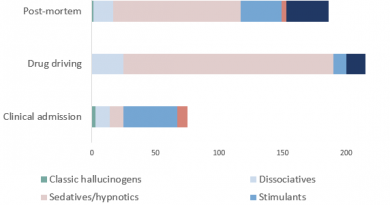UNODC: Semi-synthetics diversify the cannabis market and raise concerns about the health protection of minors
VIENNA, Austria – May 2024: There is a considerable expansion of new cannabis products, containing delta-9-THC, cannabidiol (known as CBD) and/or semi-synthetic cannabinoids. These new products include e-liquids, oils for vaping and a wide range of edible products. The first issue of the SMART Forensics Update Vol.1 “Beyond plants: semi-synthetics diversify the cannabis market” explores these new (semi-synthetic) cannabis products available on illicit drug markets in recent years.
Semi-synthetic cannabinoids can be derived from CBD or synthetized from THC. Products containing semi-synthetic cannabinoids often appear in the form of edibles and are sold in misleading packaging (e.g. resembling popular non-drug confectionery products) as well as with higher accessibility (for example via vending machines). Therefore, the risk of accidental exposure to young children and minors of particular concern.
For example, the US National Poison Centre received 2,362 cases between 1st January 2021 and 28th February 2022, who reported exposure to delta-8-THC products and 41% of these were pediatric patients (i.e. under the age of 18), many of which required health care facility evaluation.[i]

Four semi-synthetic cannabinoids (hexahydrocannabiphorol, hexahydrocannabinol acetate, hexahydrocannabinol and tetrahydrocannabidiol (H4-CBD) were identified in seized material reported to UNODC. As semi-synthetic cannabinoids have only recently emerged in drug products, there is a lack of robust, well-controlled studies on their pharmacological activity, toxicological properties, and potential for producing harmful effects. However, some adverse effects from delta-8-THC and other semi-synthetic cannabinoid products have been reported in the scientific literature. Like THC, the most commonly reported adverse effects include respiratory problems, reduced blood pressure and heart rate, confusion, sedation or reduced consciousness and decreased psychomotor activity[ii]. Psychotic-like symptoms have also been observed in case studies including paranoia, hallucinations, and panic attacks[iii].
Health care and emergency service providers need to be aware that due to the risk of unintended exposure, such symptoms may also be present in patients not reporting drug exposure.
——————————–
[i] United States Food & Drug Administration. 5 Things to Know about Delta-8 Tetrahydrocannabinol – Delta-8THC 2022. Available from: https://www.fda.gov/consumers/consumer-updates/5-things-know-about-delta-8-tetrahydrocannabinol-delta-8-thc.
[ii] Centers for Disease Control and Prevention. Increases in Availability of Cannabis Products Containing Delta-8 THC and Reported Cases of Adverse Events 2021. Available from: https://emergency.cdc.gov/han/2021/han00451.asp.
Kruger JS, Kruger DJ. Delta-8-THC: Delta-9-THC’s nicer younger sibling? Journal of Cannabis Research. 2022 2022/01/04;4(1):4.
Kruger DJ, Bone CC, Meacham MC, Klein C, Kruger JS. THC-O-Acetate: Scarce Evidence for a Psychedelic Cannabinoid. J Psychoactive Drugs. 2023 Jun 29:1-5. PubMed PMID: 37381980. Epub 20230629. eng.
[iii] Bozman ME, Manoharan SVRR, Vasavada T. Marijuana variant of concern: Delta 8-tetrahydrocannabinol (Delta-8-THC, Δ8-THC). Psychiatry Research Case Reports. 2022 2022/12/01/;1(2):100028. 33. Leas EC, Harati RM, Satybaldiyeva N, Morales
NE, Huffaker SL, Mejorado T, et al. Self-reported adverse events associated with Δ8-Tetrahydrocannabinol (Delta-8-THC) Use. Journal of Cannabis Research. 2023 2023/05/23;5(1):15 .
Miller CR, Burk BG, Fargason RE, Birur B. Delta-8-THC association with psychosis: A case report with literature review. Front Psychiatry. 2023;14:1103123. PubMed PMID: 36890985. Pubmed Central PMCID: PMC9986552. Epub 20230220. eng
For more information, please see:
SMART Forensics Update Vol.1: “Beyond plants: semi-synthetics diversify the cannabis market”
UNODC, Recommended methods for the identification and analysis of cannabis and cannabis products (March 2022)
EWA News: October 2023 – UNODC EWA: The emergence of semi-synthetic cannabinoids



